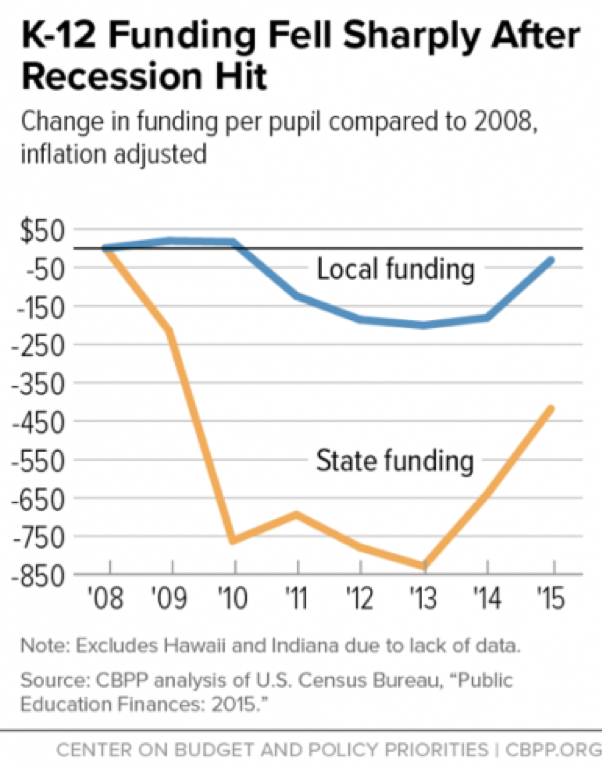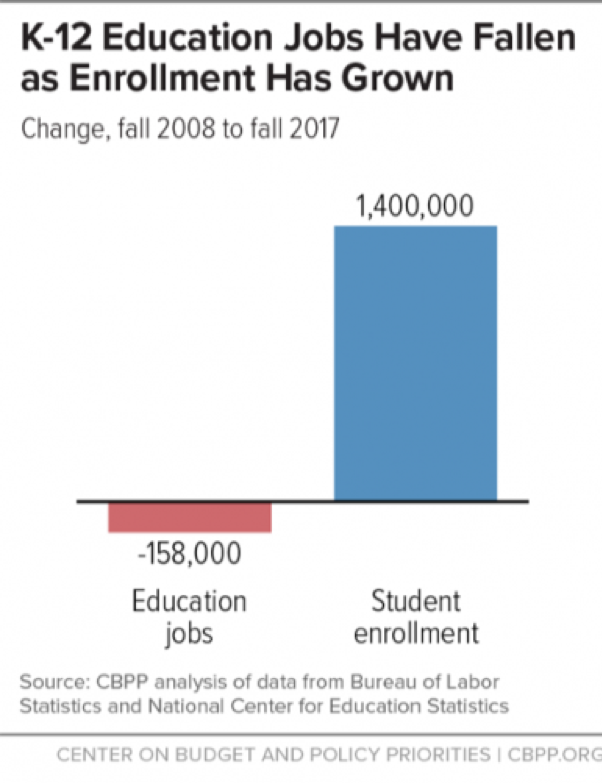All across the country, kids are strapping on their backpacks, sharpening their pencils, and heading back to school. However, a new brief from the Center on Budget and Policy Priorities, a progressive think tank serves as a timely reminder that kids in many states will be returning to schools that are still deeply under-funded.

In the aftermath of the Recession, states dramatically cut funding for K-12 schools, as the chart to the left (from a previous CBPP report) illustrates.
While a number of state and local governments have since restored funding—nationally, overall state and local per-pupil funding has reached pre-Recession levels—certain states are still lagging behind considerably. In the 2017–18 school year, 12 states—Oklahoma, Texas, Kentucky, Alabama, Arizona, West Virginia, Mississippi, Utah, Kansas, Michigan, North Carolina, and Idaho—cut general funding for schools by at least 7 percent from 2008 levels. Local government per-student funding in 2016 was also still below pre-Recession levels in 19 states, and inflation-adjusted funding for the Title I federal program is 5 percent lower than it was in 2008.

These spending cuts have had a number of meaningful effects on schools and students. Teacher pay in many states has essentially stagnated; prior to a strike, Oklahoma’s public school teachers hadn’t had a raise in a decade. In the face of low pay and benefits, school districts have struggled to recruit and retain skilled educators. They’ve also been forced to cut many positions. As the chart to the left, from the new CBPP brief, demonstrates, the number of “school workers” (which includes staff such as librarians and school nurses) nationwide has fallen—even as enrollment has increased.
Some schools, particularly those in rural areas, have been forced to convert to four-day weeks. Advocacy groups in many states are pursuing school funding lawsuits. And all across the country, teachers, parents, and public school students have gone on strike and staged demonstrations protesting low teacher compensation and poor conditions at public schools.
Educators in a number of states have won notable victories in recent months as a result of these protests. In West Virginia, the governor signed a bill granting teachers and state employees a 5 percent raise. In Kentucky, the Republican legislature actually overrode Governor Matt Bevin’s veto of a bill increasing funding for public schools. In Arizona, teachers won a 19 percent pay raise (over three years). And, in Oklahoma, teachers won raises for both themselves and school support staff.
Nonetheless, schools in many states are still underfunded. And the teachers who spurred these recent victories, meanwhile, are aware that the fight is not over, and in the wake of the springtime protests, many educators have launched successful political campaigns.




